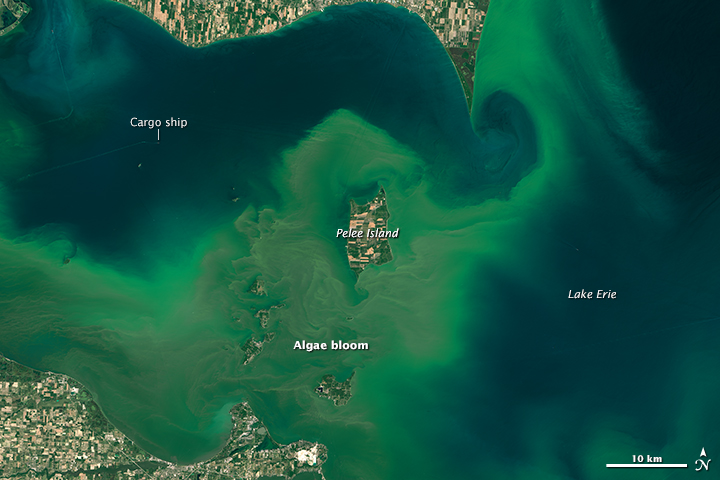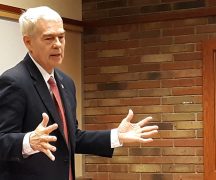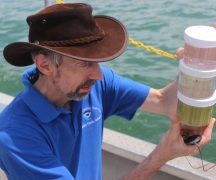By JAN LARSON McLAUGHLIN
BG Independent News
A perfect storm of sorts has led to the latest effort to fight for the health of Lake Erie – including weather projections of a moderate to bad year for algal blooms.
So far this year, the lake has been the focus of a federal court order, U.S. EPA emphasis, Ohio EPA impairment declaration and a less than ideal National Oceanic and Atmospheric Administration forecast.
“All these factors created a sense of urgency that perhaps should have already been there,” State Senator Randy Gardner, R-Bowling Green, said.
And others in the state legislature seem to agree, showing strong bipartisan support in the General Assembly as a bill and a proposed statewide bond issue was introduced Wednesday in the Ohio Senate and House of Representatives.
The Clean Lake 2020 Plan, introduced by Gardner and State Rep. Steve Arndt, R-Port Clinton, includes funding of up to $36 million in 2018 for efforts to reduce algal blooms through conservation practices and other Lake Erie initiatives. Also proposed is a Clean Water Ohio Bond Issue that would appropriate $100 million per year for 10 years after statewide approval by voters.
Gardner believes that even those Ohio voters at the southern end of the state will support the bond issue since it involves help for more than just Lake Erie. The Ohio River has also seen its share of algal bloom problems.
But the primary focus will be on Lake Erie, since an estimated 5 million people rely on the lake for drinking water, and tens of thousands of jobs depend on the lake.
“That demands that the priority be on Lake Erie,” he said.
The Ohio EPA’s declaration that the open waters of Lake Erie are impaired means little if the state doesn’t act, Gardner said.
“The most important thing is – what do we do about it,” he said. “It’s what we do from now.”
“Almost everyone realizes there’s a lot of work to be done to help the lake,” he said.
One of the biggest factors in the algal bloom issue is something state legislators can’t control – heavy rainfall events.
“It just means we have to be more aggressive and spend more on the right strategies to get it done,” Gardner said.
The Clean Lake 2020 Plan has not only garnered bipartisan support in the state legislature, but also support from farm, environmental and business groups.
They all seem to realize that since the lake is worth millions of dollars to the state, it’s worth spending money to defend it, Gardner said.
But voters’ support will also be needed to provide long-term funding to fix the lake.
“We’ve been reluctant to go to the ballot before now,” he said.
The Clean Lake 2020 Plan includes the following provisions:
- Ohio State Sea Grant/Stone Lab: Capital funds of $2.65 million for research lab space and in-lake monitoring equipment consisting of real-time buoys and water-treatment plant monitoring devices.
- Healthy Lake Erie Initiative: Additional investment of $10 million (on top of the $10 million in the just-passed Capital Appropriations Act) to support projects to reduce open lake disposal of dredged materials into Lake Erie by 2020, as Ohio law requires.
- Soil & Water Conservation Support Fund: Funding of $3.5 million to support county soil and water conservation districts in the Western Lake Erie Basin for staffing and to assist in soil testing, nutrient management plan development, enhanced filter strips and water management, and other conservation support.
- Targeted Phosphorus Reduction Fund: Funding of up to $20 million at the Ohio Department of Agriculture, in consultation with the Lake Erie Commission and the Ohio Soil & Water Commission, to establish programs to reduce total phosphorus and dissolved reactive phosphorus in subwatersheds of the Western Lake Erie Basin. Programs may include capital funds for purchasing of equipment for subsurface placement of nutrients into the soil, equipment for nutrient placement based on GIS soil testing and variable rate technology, water management efforts, manure conversion technologies, tributary monitoring, and edge-of- field drainage structures.
The Ohio Clean Water Bond Issue could support many of these activities over a 10-year period, but would also include waste water and water treatment plant support, water quality research and water resource management.
Both Gardner and Arndt acknowledged Ohio EPA’s leadership role in assisting area waste water and water treatment plants following the Toledo water crisis of 2014. In addition, millions of dollars in collaborative algae research at Ohio colleges and universities including Ohio State’s Stone Lab program have been implemented by the Department of Higher Education. Better tributary monitoring, projects to reduce open lake dumping of dredged materials, fertilizer applicator certification mandates and passage of the Clean Lake Erie Act of 2015 have all been part of Ohio’s efforts since 2013.





